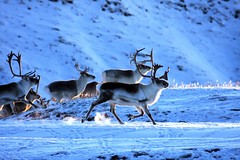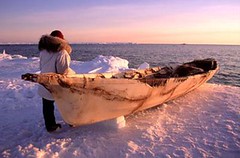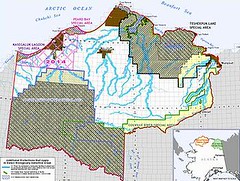 美國內政部長沙拉薩(Ken Salazar)13日向國會提案給予阿拉斯加國家石油保護區(NPR-A)新的石油及天然氣開採許可。經過與阿拉斯加北坡領導人的兩日會議後,沙拉薩表示此項計畫會將馴鹿群、候鳥棲地、丘陵地、脆弱的海洋資源及阿拉斯加原住民的永續生活形態及文化層面納入保護。「為了利用阿拉斯加國家石油保護區潛在的石油和天然氣,我們需要一個有助於從這個偏遠的位置帶給市場安全的能源計劃,同時也保護野生動物和阿拉斯加原住民的生存權。」沙拉薩在電視記者會中表示。
美國內政部長沙拉薩(Ken Salazar)13日向國會提案給予阿拉斯加國家石油保護區(NPR-A)新的石油及天然氣開採許可。經過與阿拉斯加北坡領導人的兩日會議後,沙拉薩表示此項計畫會將馴鹿群、候鳥棲地、丘陵地、脆弱的海洋資源及阿拉斯加原住民的永續生活形態及文化層面納入保護。「為了利用阿拉斯加國家石油保護區潛在的石油和天然氣,我們需要一個有助於從這個偏遠的位置帶給市場安全的能源計劃,同時也保護野生動物和阿拉斯加原住民的生存權。」沙拉薩在電視記者會中表示。
在優先方案「替代方案B-2(Alternative B-2)」中,提及可供出租的1180萬畝土地含括阿拉斯加國家石油保護區可出租區域中主要石油資源。即將開放的這個區域並不影響北極國家野生生物保護區,該保護區位於預定出租的區域的東邊。
如果這個方案受批准,可出租範圍內預計擁有以發現即未發現的約5億4900萬桶具經濟價值可採石油、及870萬兆立方呎的天然氣資源。
沙拉薩提到,「這項方案將允許我們繼續擴大阿拉斯加國家石油保護區租賃範圍,如同歐巴馬政府過去三年持續聚焦於擴充暨安全又負責任的石油及天然氣資源開發,以提供企業為滿足即時需求所發展的基礎建設。」
 13日確認的方案包含一條連結現存油管將原油運送到市場的油管。沙拉薩表示,「將有一條油管穿過阿拉斯加國家石油保護區。這項方案內並沒有排除油管,在開發楚科奇海的石油資源過程油管是必要的。」
13日確認的方案包含一條連結現存油管將原油運送到市場的油管。沙拉薩表示,「將有一條油管穿過阿拉斯加國家石油保護區。這項方案內並沒有排除油管,在開發楚科奇海的石油資源過程油管是必要的。」
「這項計畫提醒我們在規劃時須兼顧保護極區「美國寶藏」的需求。這些寶藏包括了柯維爾河的猛禽;波弗特海岸、特雪布克湖及佩爾德灣(Peard Bay)的北極熊;及可能是地球上最壯觀的馴鹿群。」
阿拉斯加國家石油保護區是北極圈內最大的候鳥繁殖地之一,也是成千上萬的水禽及岸鳥的夏棲地,包括黑雁總族群量30%的棲地。
阿拉斯加國家石油保護區提供了北極馴鹿的生育地,北極馴鹿是阿拉斯加最大的動物族群,約有32萬5千隻、另有5萬5千 個特雪布克馴鹿群。這些族群量提供超過40個阿拉斯加原住民村的生計來源。
石油開發計劃將作為阿拉斯加國家石油保護區「整合行動計畫及環境影響說明書」(IAP/EIS),於今年稍晚詳細分析後將開放公眾評論。
這份IAP/EIS草案於3月30日提出,呈現阿拉斯加國家石油保護區4份管理方案徵求公眾意見,總共收到超過40萬份公眾回應。
IAP/EIS定稿將以由「替代方案B」修改後的「替代方案B-2」做為優先方案。IAP/EIS定稿公布後,在部長做最後決定前將有30天供公眾審查。
土地管理局局長Mike Pool向記者表示:「當我們考量能源供給、阿拉斯加原住民的重要性及野生動物資源,致力於阿拉斯加國家石油保護區最佳經營平衡,我們持續聆聽利益相關者及公眾的聲音。」「作為整個阿拉斯加國家石油保護區第一個整合型行動計畫,這將成為未來的藍圖來協助從(初時的)租賃及謹慎勘探轉型至(未來)量產和開採。」
剛從北極回來的荒野協會總裁Jamie Williams表示:「沙拉薩部長發表的內容令人振奮,而且讓我們往保護阿拉斯加國家石油保護區西極區內重要的棲境更進一步。沙拉薩部長的決定反映出這些景觀屬於全美國人。它藉由允許在保護區內較不敏感的1180萬畝土地鑽油而保護了保護區內重要的生態及生存區域。」
「雖然土地管理局的優先管理策略允許設立油管運輸離岸石油到市場,我們很高興這個方案無法通過特雪布克湖的馴鹿棲地。管理者在保護區內的土地上調整策略來達到正確的平衡。在沒有永久性保護區北極區的海上,仍缺乏上述正確的平衡。」
殼牌是第一個得到楚科奇海鑽油許可的公司,計畫今年夏天開始鑽油;由於仍未達到內政部新的漏油應變計劃要求,在預定鑽油區冰層結冰前開始的機會稍縱即逝。
多數殼牌公司的北極鑽井船隊目前停泊在阿留申群島的荷蘭港。該公司正在等待北極挑戰者牽引船改造完成及美國海岸防衛隊對改裝船隻的認證。
殼牌的承包商超級能源(Superior Energy)在白令海及華盛頓為駁船重新設計新的圍堵漏油系統,這個系統可以在油井爆炸的情況下(類似2010年BP在墨西哥灣的深水地平線鑽油平台事件)蒐集漏油。
在深水地平線鑽油平台事件後,內政部根據一些專家調查委員會的建議,更新鑽油安全及漏油圍堵標準。
 沙拉薩表示,「殼牌必須證明他們可以符合我們在這個地方制訂的環保要求。深水地平線鑽油平台事件是嚴正的提醒,我們為美國海洋能源制訂的標準,是我們相信且我們將執行的標準。」他強調:「我將會並盡最大的努力給他們壓力,確保我們可以堅守我們設定的標準和規則。」
沙拉薩表示,「殼牌必須證明他們可以符合我們在這個地方制訂的環保要求。深水地平線鑽油平台事件是嚴正的提醒,我們為美國海洋能源制訂的標準,是我們相信且我們將執行的標準。」他強調:「我將會並盡最大的努力給他們壓力,確保我們可以堅守我們設定的標準和規則。」
沙拉薩剛飛行經過這個區域,他表示:「相較於近年,波福海和楚科奇海今年都有較多的海冰於其上;不過導致進度落後的原因並不是因為海冰,而是殼牌必須達到所有政府要求。」
數個殼牌公司的船隊,包括裝載新的鑽井設備的破冰船,本月初離開荷蘭港向北移動至殼牌在楚科奇海的鑽油點,開始進行鑽井的準備工作。
依照2011年五月歐巴馬總統對阿拉斯加國家石油保護區每年石油及天然氣租賃的指示,土地管理局在同年12月提供300萬畝土地租賃,成交17筆投標含括14萬畝土地。
今年11月該機構將對阿拉斯加國家石油保護區土地進行其他的租賃標售。
雖然去年在總統的跨部門工作小組協助協調阿拉斯加能源開發許可下,發給美國康菲石油在阿拉斯加國家石油保護區開採石油及天然氣資源的許可;截至目前為止,在阿拉斯加國家石油保護區只有一項試探性鑽油在進行。
Secretary of the Interior Ken Salazar today proposed to allow additional oil and gas development in the National Petroleum Reserve in Alaska, NPR-A. After two days of meetings with North Slope leaders, Salazar said the plan would protect the region’s caribou herds, migratory bird habitat, uplands, and sensitive coastal resources central to the culture and subsistence lifestyle of Alaska Natives.
“To harness the oil and gas potential of the NPR-A, we need a plan that will help the industry bring energy safely to market from this remote location, while also protecting wildlife and subsistence rights of Alaska Natives,” Salazar said on a teleconference with reporters today.
The 11.8 million acres that would be available for leasing under the preferred alternative, Alternative B-2, makes the vast majority of projected oil resources in the NPR-A available for leasing. The area that would be opened does not affect the Arctic National Wildlife Refuge, which is situated east of the area proposed for leasing.
The area available for leasing if this alternative is approved is estimated to hold roughly 549 million barrels of economically recoverable oil and some 8.7 trillion cubic feet of natural gas – both discovered and undiscovered.
“This proposal would allow us to continue to expand our leasing in the NPR-A, as we have done over the last three years as part of the Obama Administration’s focus on expanding safe and responsible oil and gas development, and builds on our efforts to help companies develop the infrastructure that’s needed to bring supplies online,” Salazar said.
The preferred alternative identified today allows for a pipeline that would connect with existing lines to bring the oil to market. “There is an openness to have pipeline to cross the NPRA,” Salazar said. “This alternative does not foreclose a pipeline, which would be necessary to develop oil reserves in the Chukchi Sea.”
“This plan also strikes an important balance by recognizing the need to protect America’s treasures in the Arctic, from the raptors of the Colville River and the polar bears of the Beaufort Sea coast, to Teshekpuk Lake, Peard Bay, and some of the largest caribou herds on Earth,” he said.
The NPR-A is one of the Arctic’s greatest migratory bird nesting and molting areas and is the summer home for hundreds of thousands of waterfowl and shorebirds, including critical molting areas for up to 30 percent of the entire population of Pacific Flyway brant goose.
The NPR-A provides calving areas and insect relief areas for the Western Arctic Caribou Herd, Alaska’s largest herd at roughly 325,000 animals, and the 55,000 animal Teshekpuk Caribou Herd. These populations are a subsistence resource for over 40 northern and western Alaska Native villages.
The petroleum development plan will be analyzed in detail and presented for public review late this year as the preferred alternative for the NPR-A Integrated Activity Plan and Environmental Impact Statement, IAP/EIS.
The Draft IAP/EIS, released March 30, presented four future management alternatives for the NPR-A for public comment. More than 400,000 public comments were received.
The Final IAP/EIS will include Alternative B-2, a modified version of Alternative B, as the preferred alternative.
The release of the Final IAP/EIS starts a 30-day public review period before the secretary may issue a final decision.
“With its energy supplies, importance to Alaska Natives, and wildlife resources, it is vital that we continue to hear from the many stakeholders and the public as we work to strike the right management balance in the NPR-A,” acting Bureau of Land Management Director Mike Pool told reporters today.
“As the first integrated activity plan for the entire NPR-A, this will provide a roadmap to help facilitate the transition from leasing and cautious exploration to production and smart development,” said Pool.
Wilderness Society President Jamie Williams, who just returned from the Arctic, said, “Secretary Salazar’s announcement is heartening, and puts us one step closer to protecting globally important habitat in the Western Arctic’s National Petroleum Reserve-Alaska. This landscape belongs to all Americans, and Secretary Salazar’s decision reflects that. It prevents oil and gas drilling in parts of the Reserve that are important ecologically and for subsistence, while allowing drilling in 11.8 million acres of the Reserve’s less sensitive areas.”
“Although the Bureau of Land Management’s preferred management strategy allows for the option of a pipeline to transport offshore oil to market, we are pleased that such a project could not pass through critical caribou habitat in the Teshekpuk Lake area,” Williams said. “The Administration is moving to find the right balance on lands within the NPR-A. Offshore in the Arctic, where there are no permanently protected areas, this balance is still lacking.”
Shell, the first oil company to be permitted for drilling in the Chukchi Sea, had planned to drill there this summer, but has not been able to meet the Interior Department’s new oil spill prevention requirements. The window of opportunity before ice freezes over the planned drilling area is rapidly closing.
Most of Shell’s Arctic drilling fleet is berthed in Dutch Harbor in the Aleutian islands. The company is awaiting completion of retrofits to its Arctic Challenger containment barge and U.S. Coast Guard certification of the reconfigured vessel.
Shell contractor Superior Energy is retrofitting the barge in Bellingham, Washington with a new containment system that would collect oil from a leaking wellhead in the event of a subsea well blowout similar to the BP/Deepwater Horizon blowout in 2010 that spilled some five million barrels of oil into the Gulf of Mexico.
After the Deepwater Horizon spill, the Interior Department updated its drilling safety and oil spill containment standards based on the recommendations of several expert investigative commissions.
Salazar said today, “It’s the necessary for Shell to be able to demonstrate that they can meet the environmental requirements we have put into place. The Deepwater Horizon is a stark reminder that the standards we have set forth to regulate ocean energy in America are standards that we believe in and standards that we will enforce.”
“I will hold their feet to the fire to make sure we are doing everything we can to abide by the standards and regulations we have set,” Salazar emphasized.
“Both the Beaufort and the Chukchi had more ice on them than in recent years,” he said after flying over the area this weekend. “The cause for the delay is not the ice, it’s if Shell has the capability to comply with government requirements.”
Several vessels from Shell’s fleet, including an icebreaker carrying the company’s new well capping stack, moved north from Dutch Harbor earlier this month to start drilling preparations at one of Shell’s Chukchi Sea sites.
Following President Barack Obama’s direction in May 2011 that annual oil and gas lease sales be conducted in the NPR-A, BLM offered three million acres in a lease sale last December that generated 17 winning bids covering more than 140,000 acres.
The agency will conduct another lease sale in the NPR-A this coming November.
To date, only exploratory drilling has occurred within the NPR-A, although last year, with the assistance of the President’s Interagency Working Group on Coordination of Domestic Energy Development and Permitting in Alaska, permits were issued to ConocoPhillips to allow for future production of oil and gas resources within the NPR-A.
※全文及圖片詳見 ENS





